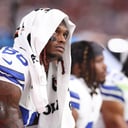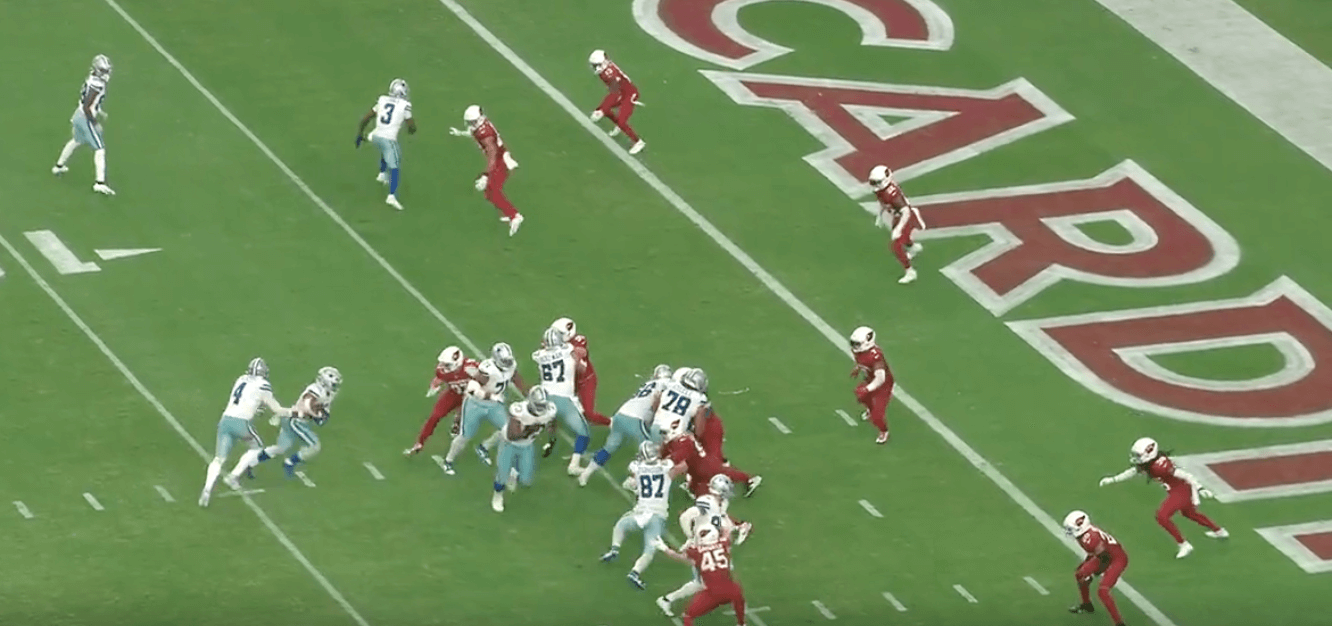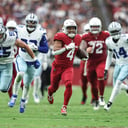Almost exactly nine years ago, on Sept. 29, 2014, after the Kansas City Chiefs demolished the New England Patriots on Monday Night Football, Patriots head coach Bill Belichick was asked in a postgame news conference if the quarterback position for the Patriots would be evaluated.
Belichick scoffed.
Advertisement
You know the story from there. The quarterback that was the subject of evaluation that night was Tom Brady, who finished top-5 in MVP voting for the next four seasons — winning the award once — and won four more Super Bowls in his illustrious career, including that very season.
The point of that reflection, beyond the Patriots coming to town Sunday, is that September overreactions happen on a regular basis. They don’t discriminate by player or team and take no regard for past resumes. In our fast-paced society, a bad showing on Sundays is one of the few instances in which folks truly live fully in the moment.

GO DEEPER
Examining the Cowboys' offensive woes — red zone issues, play calling and more
Right now, it is a bad moment for the Dallas Cowboys as it pertains to their red zone offense. It was atrocious Sunday, serving as one of a few things that carry the brunt of the blame for the underwhelming loss. The Cowboys reached the red zone five times yet punched the ball in the end zone just once.
“The most important thing is that we’re getting down there more than anybody,” coach Mike McCarthy said “We lead the league in 10-plus drives, so we’re moving the ball. That’s the hard part. We have some strong feelings that we’re not going to talk about in here (publicly) on things we can improve on.”
In fairness, this isn’t exactly a one-game overreaction. In Week 2 against the New York Jets, the Cowboys were 2 for 6 in the red zone, something quarterback Dak Prescott even lamented on after that game. It just wasn’t a big talking point because the team won big, and as the saying goes, winning is the greatest deodorant.
When a combined 3 for 11 happens in back-to-back weeks, it will make people forget really fast about the 3-for-4 red zone showing in Week 1 or leading the league in red zone offense last season and being No. 6 the year before that. This is 2023 and through three weeks this season, only three teams have a worse red zone efficiency than the Cowboys.
Advertisement
If one is to extend the Cowboys some leeway for how good the red zone offense was in 2021 and 2022, it makes sense to look at what made those teams tick. While we won’t turn this into an exhaustive examination of past years, let’s look at the basics.
In 2021, according to TruMedia, the Cowboys had a 63.1 percent red zone efficiency for sixth in the NFL. Their top three targets in the red area were Amari Cooper (17), Ezekiel Elliott (14) and Dalton Schultz (14). CeeDee Lamb (10) and Cedrick Wilson (nine) rounded out the top five. As you can see, four out of the top five options are no longer with the team.
Carry that over to 2022, and Schultz led the team in the red area with 16 targets, and Michael Gallup (12) and Lamb (12) were behind him and Noah Brown (11) was the last one in double digits. Again, half of those guys, including the team leader, are no longer with the team.
On the rushing side of things, it’s completely lopsided. In 2021, Elliott had 35 red zone carries, more than twice of the next two players — Prescott (15) and Tony Pollard (15) — combined. Elliott had 10 of the team’s 13 red zone rushing touchdowns. In other words, Elliott alone was the red zone rushing attack in 2021.
The margin tightened in 2022. Elliott again led the team with 35 red zone rushing attempts but Pollard was second with 23. And although Pollard had 99 rushing yards to Elliott’s 97, Elliott had 12 touchdowns to Pollard’s six.
When Brian Schottenheimer was asked about the personnel being able to create mismatches in the red zone, he pushed back on the notion that the Cowboys don’t have those options.

“We have plenty of mismatch guys,” Schottenheimer said. “When you come down to it, there were just plays where we’re this close. Brandin Cooks has one on the boundary, he’s this close. Michael (Gallup) gets behind the corner on one, it’s that close. There were plenty of opportunities. It was one of those days where it just didn’t come together. In a game like that, where you’re moving the ball up and down the field, you feel really good about it. We just were never able to find any rhythm down there.”
Advertisement
A little later, Schottenheimer was asked if it’s a matter of a lot of the red zone players departing at once and the new players having to learn how to play ball on a condensed field in much tighter space.
“Every year is different. Each week is different,” Schottenheimer said. “It’s not a personnel issue. It’s more of, ‘Hey, how do we get ourselves in more of second and manageable? How do we get ourselves in third down and manageable, when you’re not up against it a little bit?’ That’s got nothing to do with third down; that’s got to do with us not having penalties, we shot ourselves in the foot a couple of times (Sunday) with some penalties. We had seven, three in the red zone. That certainly hurts you.
“But this is not a matchup thing. We’ve got terrific players. We just have to execute better, we have to coach better and when the plays are there to be made, we have to do those things. … It’s certainly not something to do with our players. We have really, really talented guys that we feel really good about. Like anything, when you have something that you struggle with, what do you do? You emphasize it, and the way our players are wired, they’re going to bounce back and they’ll accept that challenge.”
Schottenheimer publicly defending his guys in the room is not a surprise. McCarthy, when asked about Schultz and Elliott’s prowess previously in the red zone, did chalk it up to “a good point” and gave “those guys the credit for what they accomplished in their time here” but quickly followed it up by praising their replacements, Pollard and Jake Ferguson, respectively. Again, regardless of merit, that’s expected
The Cowboys do have a lot of talent; it just looks different than it has, both in recent years and the past decade or so. A big body receiver like Dez Bryant, who the team could routinely fade up in the red zone, doesn’t exist. Gallup may be a version of that but he certainly is not that. A veteran tight end who knows how to mentally and physically work that area, like Jason Witten or Schultz, isn’t on the roster.
That doesn’t mean there aren’t talented players available and it doesn’t excuse the Cowboys not being much better in the red zone. The players must adjust and grow into these new roles but the onus is on the coaches, too. Maybe you don’t have a Bryant-like receiver or a Schultz-like tight end, but you have a lot of players, such as Pollard, KaVontae Turpin and Deuce Vaughn, who are excellent in space. And though Gallup may not be Bryant, he still is a big-bodied receiver who should be getting more opportunities to win battles for the ball in the air than he is.
Finally, there’s Prescott. It’s a fine line when you have a $40 million franchise quarterback with how much you ask him to put his body on the line. Prescott seems to do it voluntarily every so often — his third-down run against the Cardinals and hard fall against the New York Jets in Week 2 come to mind — but there aren’t many organized run calls or run-pass options.
Advertisement
That may be a well the Cowboys want to drink from a little more often, even if they do it more carefully and with a greater emphasis of getting out of harm’s way at the first sight of danger. For example, this handoff on first-and-goal against the Cardinals could have greatly benefited from being an RPO.

Whether Prescott runs into the end zone or not, he would not lose two yards, as Pollard did after the handoff. Schottenheimer, in lieu of harping on personnel selection, talked about being better on first and second downs to set up better third-down situations. Not losing two yards would be a great start to that, as would not being so predictable in running on most first and second downs, though the decimated offensive line Sunday may have factored into that more.
Back to Prescott, in his four years prior to 2020, when he missed most of the season after a compound fracture in his ankle, Prescott had 53 rushes for 220 yards and 21 touchdowns rushing in the red zone. That comes out to 13.25 carries, 55 yards and 5.25 touchdowns per season. In the two years since his injury, excluding this season, Prescott has 21 carries for 51 yards and two touchdowns. That comes out to 10.5 carries, 25.5 yards and one touchdown per season.
Without Elliott, Prescott’s usage on the ground may be even more valuable. Cowboys defensive coordinator Dan Quinn, when asked for general thoughts on how he approaches defending in the red zone, made the astute point that the red zone can’t just be painted as one big picture.

GO DEEPER
'Upset' Dan Quinn didn't see 'relentless energy' he expects from Cowboys' defense
“It also depends where you’re at, because the higher you are (the offense) can still throw over the top of you,” Quinn said. “Sometimes that mid-red zone, in that space is where the runs go up in that area. … As you get closer down in the low red zone, the flat and the back line, that’s the stuff you have to really defend, horizontally and not as much vertically. … You have to probably think square and strong in the run first and make sure if they are going to throw something, again, when you’re high (in the red zone), you have some space if you want to double somebody or play a different coverage, you can. When you get down low, there’s not a lot of gray area or time to mis-hit on something, so you better be pretty firm, playing run first, knowing that you’re going to have to play some man-like coverages down low.”
The Cowboys have struggled in the low red zone this season. In their nine red zone drives that didn’t end in a touchdown, they faltered, respectively at these yard lines: 2, 17, 3, 8, 12, 8, 4, 8 and the 6. As you can see, while the red zone is an issue, inside the 10 is especially an issue.
Whether the Cowboys want to verbalize publicly or not, they do have a personnel issue in the red zone. It’s not that they don’t have the players to have success; they just haven’t figured out yet how to put those players in the best position to have success.
Advertisement
Prescott’s legs, within reason, have to be a bigger part of the equation, or at least just a bigger threat to open things up elsewhere. Asking Pollard to be Elliott isn’t the answer, nor is asking first-year starter Ferguson to pick up where five-year vet Schultz left off. That’s not a knock on a player like Ferguson, but even Schultz wasn’t the primary tight end option until his third season. These developments take time.
The Cowboys are in the business of winning right now. They need to come up with answers fast, because as Lamb said Sunday, they “ain’t going to get nowhere with three points.”
(Top photo of Kyzir White’s interception: Joe Camporeale / USA Today)
The Football 100, the definitive ranking of the NFL’s best 100 players of all time, goes on sale this fall. Pre-order it here.

